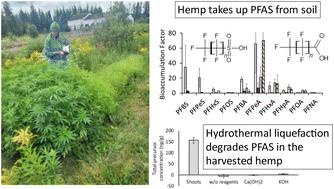当前位置:
X-MOL 学术
›
Environ. Sci. Adv.
›
论文详情
Our official English website, www.x-mol.net, welcomes your
feedback! (Note: you will need to create a separate account there.)
A comprehensive trial on PFAS remediation: hemp phytoextraction and PFAS degradation in harvested plants
Environmental Science: Advances ( IF 3.5 ) Pub Date : 2024-01-05 , DOI: 10.1039/d3va00340j Sara L Nason 1 , Sara Thomas 1 , Chelli Stanley 2 , Richard Silliboy 2, 3 , Maggie Blumenthal 2 , Weilan Zhang 4 , Yanna Liang 4 , Jasmine P Jones 1 , Nubia Zuverza-Mena 1 , Jason C White 1 , Christy L Haynes 5 , Vasilis Vasiliou 6 , Michael P Timko 7 , Bryan W Berger 8
Environmental Science: Advances ( IF 3.5 ) Pub Date : 2024-01-05 , DOI: 10.1039/d3va00340j Sara L Nason 1 , Sara Thomas 1 , Chelli Stanley 2 , Richard Silliboy 2, 3 , Maggie Blumenthal 2 , Weilan Zhang 4 , Yanna Liang 4 , Jasmine P Jones 1 , Nubia Zuverza-Mena 1 , Jason C White 1 , Christy L Haynes 5 , Vasilis Vasiliou 6 , Michael P Timko 7 , Bryan W Berger 8
Affiliation

|
Per- and polyfluoroalkyl substances (PFAS) are a class of recalcitrant, highly toxic contaminants, with limited remediation options. Phytoremediation – removal of contaminants using plants – is an inexpensive, community-friendly strategy for reducing PFAS concentrations and exposures. This project is a collaboration between the Mi'kmaq Nation, Upland Grassroots, and researchers at several institutions who conducted phytoremediation field trials using hemp to remove PFAS from soil at the former Loring Air Force base, which has now been returned to the Mi'kmaq Nation. PFAS were analyzed in paired hemp and soil samples using targeted and non-targeted analytical approaches. Additionally, we used hydrothermal liquefaction (HTL) to degrade PFAS in the harvested hemp tissue. We identified 28 PFAS in soil and found hemp uptake of 10 of these PFAS. Consistent with previous studies, hemp exhibited greater bioconcentration for carboxylic acids compared to sulfonic acids, and for shorter-chain compounds compared to longer-chain. In total, approximately 1.4 mg of PFAS was removed from the soil via uptake into hemp stems and leaves, with an approximate maximum of 2% PFAS removed from soil in the most successful area. Degradation of PFAS by HTL was nearly 100% for carboxylic acids, but a portion of sulfonic acids remained. HTL also decreased precursor PFAS and extractable organic fluorine. In conclusion, while hemp phytoremediation does not currently offer a comprehensive solution for PFAS-contaminated soil, this project has effectively reduced PFAS levels at the Loring site and underscores the importance of involving community members in research aimed at remediating their lands.
中文翻译:

PFAS 修复的综合试验:大麻植物提取和收获植物中的 PFAS 降解
全氟烷基物质和多氟烷基物质 (PFAS) 是一类顽固性剧毒污染物,补救措施有限。植物修复——利用植物去除污染物——是一种廉价且对社区友好的策略,可降低 PFAS 浓度和暴露量。该项目是 Mi'kmaq 民族、Upland Grassroots 和多个机构的研究人员之间的合作,他们使用大麻进行了植物修复现场试验,以去除前 Loring 空军基地土壤中的 PFAS,该基地现已归还给 Mi'kmaq 民族国家。使用目标和非目标分析方法对成对的大麻和土壤样品中的 PFAS 进行了分析。此外,我们使用热液液化 (HTL) 来降解收获的大麻组织中的 PFAS。我们在土壤中鉴定出了 28 种 PFAS,并发现大麻吸收了其中 10 种 PFAS。与之前的研究一致,与磺酸相比,大麻表现出更高的羧酸生物浓度,与长链化合物相比,大麻对短链化合物表现出更高的生物浓度。总共,通过大麻茎和叶的吸收,从土壤中去除了大约 1.4 毫克的 PFAS,在最成功的地区,从土壤中去除的 PFAS 最多大约为 2%。 HTL 对 PFAS 的羧酸降解率接近 100%,但保留了部分磺酸。 HTL 还减少了前体 PFAS 和可萃取有机氟。总之,虽然大麻植物修复目前无法为 PFAS 污染的土壤提供全面的解决方案,但该项目有效降低了 Loring 场地的 PFAS 水平,并强调了让社区成员参与旨在修复其土地的研究的重要性。
更新日期:2024-01-10
中文翻译:

PFAS 修复的综合试验:大麻植物提取和收获植物中的 PFAS 降解
全氟烷基物质和多氟烷基物质 (PFAS) 是一类顽固性剧毒污染物,补救措施有限。植物修复——利用植物去除污染物——是一种廉价且对社区友好的策略,可降低 PFAS 浓度和暴露量。该项目是 Mi'kmaq 民族、Upland Grassroots 和多个机构的研究人员之间的合作,他们使用大麻进行了植物修复现场试验,以去除前 Loring 空军基地土壤中的 PFAS,该基地现已归还给 Mi'kmaq 民族国家。使用目标和非目标分析方法对成对的大麻和土壤样品中的 PFAS 进行了分析。此外,我们使用热液液化 (HTL) 来降解收获的大麻组织中的 PFAS。我们在土壤中鉴定出了 28 种 PFAS,并发现大麻吸收了其中 10 种 PFAS。与之前的研究一致,与磺酸相比,大麻表现出更高的羧酸生物浓度,与长链化合物相比,大麻对短链化合物表现出更高的生物浓度。总共,通过大麻茎和叶的吸收,从土壤中去除了大约 1.4 毫克的 PFAS,在最成功的地区,从土壤中去除的 PFAS 最多大约为 2%。 HTL 对 PFAS 的羧酸降解率接近 100%,但保留了部分磺酸。 HTL 还减少了前体 PFAS 和可萃取有机氟。总之,虽然大麻植物修复目前无法为 PFAS 污染的土壤提供全面的解决方案,但该项目有效降低了 Loring 场地的 PFAS 水平,并强调了让社区成员参与旨在修复其土地的研究的重要性。















































 京公网安备 11010802027423号
京公网安备 11010802027423号